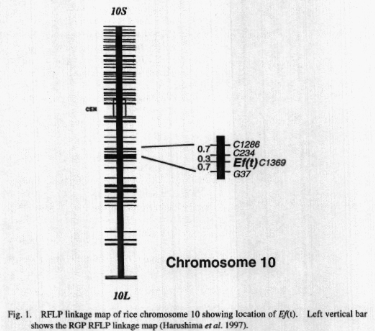K. Dot and A. Yoshimura
Plant Breeding Laboratory, Faculty of Agriculture, Kyushu
University, Fukuoka, 812-8581 Japan
Some QTLs for heading date were identified using a BC2F1
population derived from the cross between Japonica rice (Oryza sativa L.
cv. Taichung 65) and African rice (0. glaberrirna Steud., Acc. IRGC 104038)
(Doi et al. 1997) and the subsequent backcrosses with Taichung 65. In the
present report, one of the QTLs on chromosome 10 was located on the RFLP
linkage map as a major gene.
The plants heterozygous for the putative region Of the gene
for heading date on chromosome 10 (hereafter referred as EJ(t)) were selected
using RFLP markers and a BC3F5 population consisting of 147 plants was
used as the mapping population. The seeds of the mapping population were
sown on December 11, 1997 and seedlings were transplanted on January 1,
1998 at the International Rice Research Institute, Los Bafios, Philippines.
In the mapping population, early-heading (60-67 days to
heading (DTH)) plants and late heading (69-84 DTH) plants segregated in
a ratio of 105 : 42, fitting the expected 3: 1 ratio (x2= 1.000, P=0.32).
The dominant allele from 0. glaberrima caused early heading. RFLP analysis
revealed that Ef(t) was mapped on the same position as C1369 on chromosome
10 in this population size. The two loci Ef(t) and C1369 were located between
the flanking markers C234 and G37 which are linked with distance of 1.1
cM from each other (Fig. 1).
Dominant allele of Efi shortens the days to heading especially
under the short-day condition (Tsai 1997). Ef(t) showed similar characteristics
to Efi (unpublished data). Moreover, Efi was located on the identical region
on chromosome 10 (Sato et a!. 1988, Yoshimura et a!. 1997). These results
indicate that there is a possibility that Ef(t) is an allele of Efi locus.
This study was supported in part by the Program for Promotion
of Basic Research Activities for Innovative Biosciences. The authors are
grateful to Drs. G. S. Khush and E. A. Angeles, IRRI, Philippines, who
kindly planted the mapping population.
|

|
—.
|
Breed. Sci. 47 (Suppl. 1): 44. (in Japanese)
|
|
A.
|
Parco, H. Kajiya, N. Huang, K. Yamamoto, Y. Nagamura, N.
Kurata, G.S. Khush andT. Sasaki, 1998. A
|